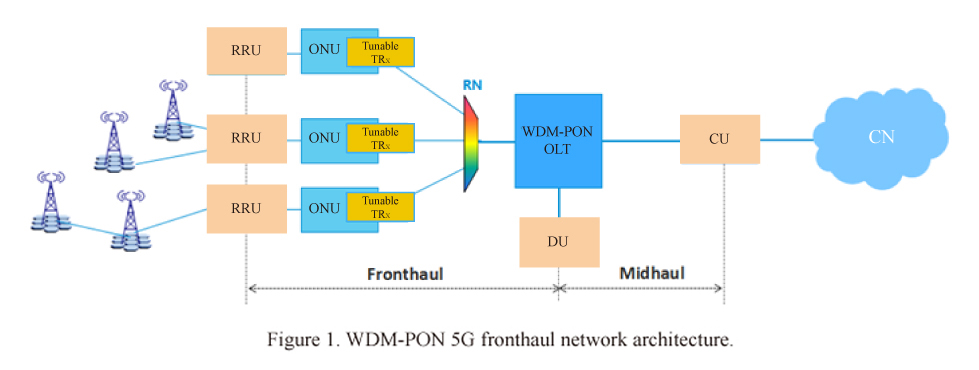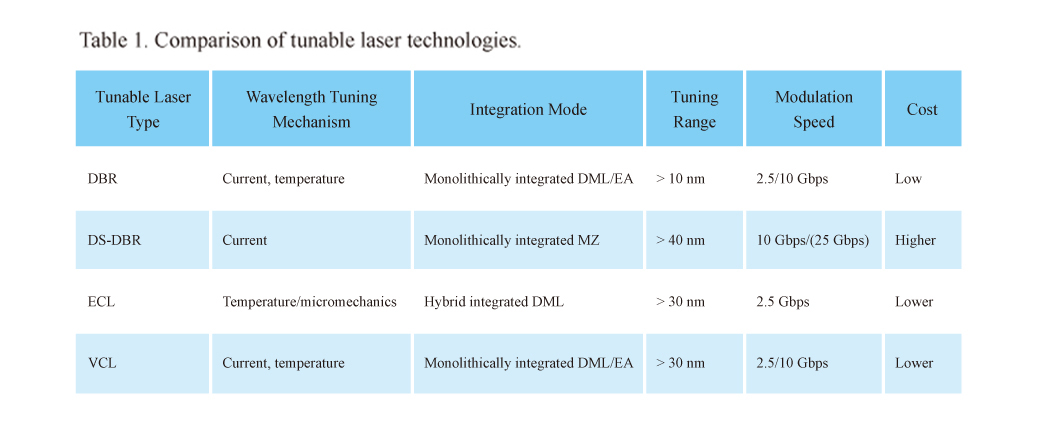Key WDM-PON Technologies for 5G Fronthaul
To date, research in 5G networks has boomed and entered the critical stage of standard development and trials. 5G networks have significant improvements in throughput, latency and number of connections, compared with 4G networks. This also imposes new challenges on fronthaul networks, including higher fiber density, higher transmission bandwidth, and lower latency. The WDM-PON technology combines the WDM technology and PON topology structure. It has unique advantages in 5G fronthaul applications, including high bandwidth, low latency, fiber savings, easy maintenance, and low costs, and has attracted great attention nowadays.
Restricted by standards and technology maturity, commercial WDM-PON networks or WDM-PON prototypes have a comparatively low rate. A single-wavelength data rate does not exceed 10 Gbps in most cases. In 2015, ITU-T developed the NG-PON2 standard, which details the architecture and indicators of WDM-PON (PtP WDM). This standard specifies line rates of up to 10 Gbps as well as auxiliary management and control channel (AMCC) that transmits wavelength allocation and assignment information and OAM data. Considering the higher bandwidth requirements of 5G fronthaul networks, ITU-T has started research on single-wavelength 25 Gbps WDM-PON applicable to 5G fronthaul networks.
WDM-PON 5G Fronthaul Network Architecture
In a 5G C-RAN fronthaul architecture, the BBU is divided into the functional entities of central unit (CU) and distributed unit (DU). The CU implements non real-time functions of the upper layers of the radio network protocol stack. Part of the network functions in the core can move to the edge and application services can be implemented at the edge. The DU implements PHY functions and transport layer functions that have stringent real-time requirements. Some PHY functions are moved to the RRU side to reduce transport cost and bandwidth between the DU and RRU. The interface between the DU and RRU has not been standardized so far. The available solutions include NGFI, eCPRI, and CPRI.
Figure 1 shows the architecture of the WDM-PON 5G fronthaul network. One DU and a plurality of RRUs are connected via a WDM-PON point-to-multipoint topology. The WDM-PON OLT is connected to the DU while the ONUs are connected to the RRUs. The WDM and AMCC technologies are used to enable transparent user data transmission between the DU and RRUs. The OLT carries the fronthaul traffic between the DU and RRUs as well as the midhaul traffic between the DU and CU.

The WDM-PON 5G fronthaul network architecture has the following technical features:
● Uses a PON topology, which reduces the amount of fiber needed by 5G fronthaul networks with high site densities. The existing fiber infrastructure and equipment room is utilized, saving the network construction and maintenance costs.
● Uses the WDM and AMCC technologies, which do not require frame processing or dynamic bandwidth allocation (DBA) scheduling. Compared with active bearer equipment and TDM PON, this architecture boasts low latency, low frequency jitter, and flexible configuration of different fronthaul interfaces.
● Offers a dedicated wavelength to each user, high transmission efficiency, and extensive bandwidth resources.
● Implements an integrated fronthaul/midhaul (XHaul) transport network with the OLT. The OLT platform and the DU pool can be deployed in the same equipment room to reduce the costs and energy consumption associated with auxiliary equipment and equipment room construction.
● Uses the colorless technology of ONU, resulting in low costs and easy maintenance.
● Supports a unified optical access platform and OLT sharing, simultaneously satisfying the service requirements of mobile users and home users.
Low-Cost High-Speed Colorless ONU
As a key technology of WDM-PON systems, colorless ONU uses the tunable ONU technology based on tunable lasers. It is easy to realize high-speed transmission by combining tunable lasers and modulators. Currently, the commercially available tunable lasers include distributed Bragg reflector (DBR) laser, digital supermode distributed Bragg reflector (DS-DBR) laser, external cavity laser (ECL), and V-cavity laser (VCL). These four solutions differ in tuning mechanism, integration mode, wavelength tuning range, and cost (Table 1). It can be seen that the 25 Gbps tunable laser is not mature enough and its applications to 5G fronthaul networks should be further studied for improved rates and reduced costs.

The tunable optical module rate can be increased through 10 Gbps tunable lasers together with high-order modulation technologies, including 4-level pulse amplitude modulation (PAM4) and optical duobinary (ODB). When the high-order modulation technologies are used for 25 Gbps tunable modules, the mature 10 Gbps optical device industrial chain can be utilized to reduce the optical device costs and accelerate the commercialization of 25 Gbps tunable optical modules. Moreover, the anti-dispersion performance of high-speed tunable lasers can be improved to increase the transmission distance supported by tunable optical modules.
The costs of tunable optical modules can be reduced by decreasing the module encapsulation costs as well as using low-cost tunable lasers. For example, AMCC can be used together with wavelength monitoring to reduce the wavelength stability requirements for tunable lasers so that the encapsulation process can be simplified and the costs can be reduced.
AMCC
The AMCC technology has been applied to transparent transmission management for 5G fronthaul WDM-PON systems. Without affecting data transmission, it manages and controls WDM-PON ONUs and tunable optical modules, covering wavelength allocation information and OAM data.
In most cases, the transparent AMCC transport is used, and such operations as encapsulation, coding, and FEC should not be performed on user data. The transparent AMCC transport can be implemented in two ways: baseband overmodulation and RF pilot tone. In baseband overmodulation, low-rate baseband signals are added to the peak of user data signals. In RF pilot tone, low-rate ASK-modulated or FSK-modulated signals are added to the peak of user data signals. Both solutions have advantages and disadvantages. Baseband overmodulation is simple with no need for ADCs and DSPs and can achieve a transmission rate of over 100 Kbps, but it requires high optical power stability for signal transmission and cannot transmit multiple signals over AMCC channel via different subcarrier frequencies. RF pilot tone is complex on the receiver side and the transmission rate is constrained by signal rate, but it has the advantage of transmitting multi-channel signals simultaneously. Both solutions may affect data signal transmission to some extent. In general, the modulation depth of AMCC signals does not exceed 10% when the optical power penalty is 1dB.
Conclusion
In the 5G era, fronthaul networks are facing new challenges due to new network architectures, new technologies, and new application features. The WDM-PON system has advantages in latency, bandwidth, fiber savings, and maintenance, and it has gained superiority in 5G fronthaul applications. By implementing efficient and flexible network architectures, low-cost colorless ONU and AMCC, low-cost and high-performance fronthaul solutions can be developed to drive 5G development and commercialization.